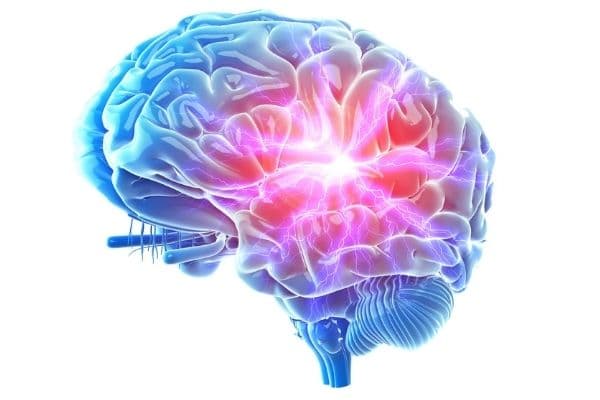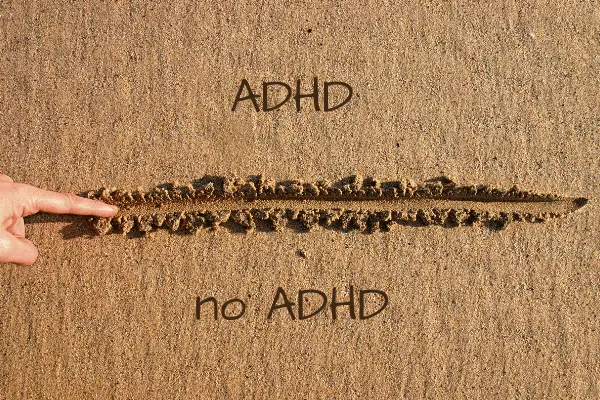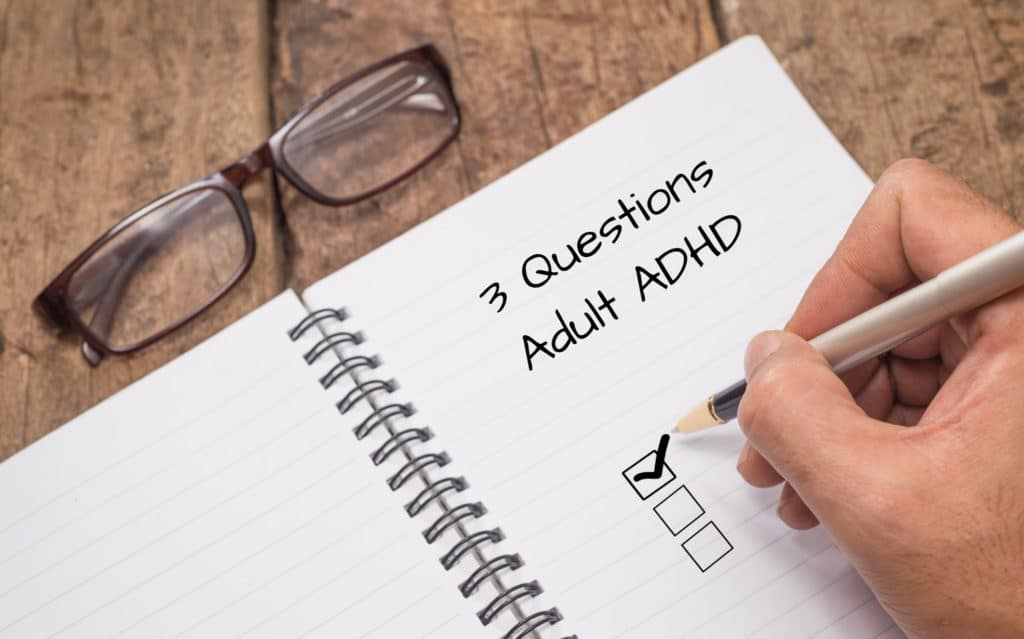Adult ADHD, it is a thing. But the medical model’s focus on impairments is limiting. Rather than viewing ADHD symptoms as an outside observer, it would be helpful to focus on what it is like to actually live with ADHD.
What is the Medical Model View of ADHD?
ADHD is considered a neurodevelopment disorder in the medical model. There is no agreement on what specifically causes ADHD. It is clear that genetics plays a major role, but there are no specific genetic tests.
There is actually no stable, agreed upon, and biologically valid concept of any psychiatric disorder. Which makes the The Diagnostic and Statistical Manual of Mental Disorders (DSM) classification of mental conditions a poor basis for biological and genetic research.

The oldest description of ADHD was found in a textbook from 1798, in a chapter called ‘Diseases of Attention’.
In 1902 a pediatrition described “an abnormal defect of moral control in children” for some children who could not control their behavior the way a typical child would, but they were still intelligent.

More recently the view of ADHD is thinking of it as more of a regulation issue. ADHD can be seen as the dysregulation of thoughts (distractable thoughts or hyperfixation), emotions (easily frustrated), and actions (need to fidget, blurting out answers).
Another way of looking at ADHD and ADHD traits is the new term Variable Attention Stimulus Trait (VAST) which is a strength based view considering benefits in addition to impairments. Did you know that a lot of entrepreneurs have ADHD? One example is Will Henshell of Focus@Will.
But the diagnosis of ADHD in the medical model continues to be based on signs and symptoms of inattention, impulsivity and hyperactivity.
I once heard someone describe the diagnosis criteria as ‘how we annoy others’. It made me laugh, but there is actually a lot of truth to that statement.
History of ADHD Description in the Medical Model
ADHD is considered a psychiatric disorder, so the diagnostic criteria of ADHD is listed in the Diagnostic and Statistical Manual of Mental Disorders (DSM). ADHD was first listed in the second edition of the DSM published in 1968 under the name hyperkinetic reaction of childhood.
In the third edition of the DSM (DSM-III) in 1980, the name was changed to attention deficit disorder (ADD). There were two subtypes of ADD: ADD with hyperactivity, and ADD without hyperactivity.

With a revision of the DSM in 1987 and the fourth edition of the DSM in 2000 ADHD was divided into 3 subtypes:
- combined type ADHD
- predominantly inattentive type ADHD
- predominantly hyperactive-impulsive type ADHD
Why Does The DSM ADHD Diagnostic Criteria Not Include Emotional Dysregulation?
Many people with ADHD have issues due to emotional dysregulation. This can present as getting frustrated easily, getting upset over ‘small things’, but also getting really excited about something they are interested in.
One term for this is Deficient Emotional Self-Regulation, Dr. Dodson (an expert in adult ADHD) has lectured about extensively. He has also coined the term ‘Rejection Sensitive Dysphoria’ and developed treatments for the worst aspect of emotional dysregulation.
But the current medical model and the DSM diagnostic criteria does not list emotional dysregulation as part of ADHD. And this is weird, because it used to be part of the description of ADHD prior to 1976.
‘Emotional impulsiveness’ was included in scientific descriptions of ADHD (although they did not use the term ADHD back then).

The DSM did not include emotional regulation in the ADHD diagnositic criteria and made it just an ‘associated problem’ for some people. Dr. Barkley (an expert in ADHD) discusses this in detail in this lecture. He says the inability to manage frustration, impatience and anger are actually common ADHD symptoms.
Why did they take emotional dysregulation out of the diagnositic criteria? One theory is that emotions were removed from the ADHD diagnostic criteria to make it easier to study ADHD.
This is because it is easier to objectively study attention and activity, but emotions are more subjective.
What are the DSM-5 ADHD Diagnostic Criteria?
The DSM-5 criteria are used to determine if someone has ADHD or not. You need a certain number of symptoms for the diagnosis, and there needs to be impairment.
You either have ADHD or you do not. This completely ignores the possibility that ADHD traits fall on a spectrum (and some have Variable Attention Stimulus Trait) or that life circumstances could worsen or improve the symptoms of ADHD.

The diagnostic criteria in the DSM-IV is the following:
DSM-5® DIAGNOSTIC CRITERIA FOR ADHD IN ADULTS
All criteria must be met for a diagnosis of ADHD in adults:
- Five or more symptoms of inattention and/or ≥5 symptoms of hyperactivity/impulsivity must have persisted for ≥6 months to a degree that is inconsistent with the developmental level and negatively impacts social and academic/occupational activities.
- Several symptoms (inattentive or hyperactive/impulsive) were present before the age of 12 years.
- Several symptoms (inattentive or hyperactive/impulsive) must be present in ≥2 settings (eg, at home, school, or work; with friends or relatives; in other activities).
- There is clear evidence that the symptoms interfere with or reduce the quality of social, academic, or occupational functioning.
- Symptoms do not occur exclusively during the course of schizophrenia or another psychotic disorder, and are not better explained by another mental disorder (eg, mood disorder, anxiety disorder, dissociative disorder, personality disorder, substance intoxication, or withdrawal).
- Symptoms must occur often
Among other criteria that must be met for a diagnosis of ADHD, several symptoms (inattentive or hyperactive/impulsive) must be present in 2 or more settings (eg, at home, school, or work; with friends or relatives; in other activities).

ADHD SYMPTOMS OF INATTENTION
- Makes careless mistakes/lacks attention to detail
- Difficulty sustaining attention
- Does not seem to listen when spoken to directly
- Fails to follow through on tasks and instructions
- Exhibits poor organization
- Avoids/dislikes tasks requiring sustained mental effort
- Loses things necessary for tasks/activities
- Easily distracted (including unrelated thoughts)
- Is forgetful in daily activities

ADHD SYMPTOMS OF HYPERACTIVITY / IMPULSIVITY
- Fidgets with or taps hands or feet, squirms in seat
- Leaves seat in situations when remaining seated is expected
- Experiences feelings of restlessness
- Has difficulty engaging in quiet, leisurely activities
- Is “on-the-go” or acts as if “driven by a motor”
- Talks excessively
- Blurts out answers
- Has difficulty waiting their turn
- Interrupts or intrudes on others
What Are ADHD Diagnostic Tools?
I wrote a post about Dr. Dodson’s 3 question test to diagnosis adult ADHD.

But if you are speaking to your doctor about adult ADHD, you do need to give him or her information that fits in with the medical model of ADHD. So you will want to use a validated tool that can be used to aid in the diagnosis of adult ADHD.
There is the Adult Self-Report Scale (ASRS-V1.1) Symptom Checklist and the DIVA-5, both of which ask about the DSM criteria for ADHD diagnosis.
Another self report scale is the Weiss functional impairment rating scale. This scale asks how your life is impaired by various symptoms including emotional dysregulation. This is an excellent add on to show how the symptoms of ADHD affect your life.
Read my review these medically validated adult ADHD assessment scales.
References
- Toward Precision Medicine in ADHD
- Dr. Barkley Lecture: 30 Essential Ideas you should know about ADHD, 1B Inhibition, Impulsivity, and Emotion
- Diagnostic and Statistical Manual of Mental Disorders, Fifth Edition (DSM-5)
- ADHD 2.0
- Adult Self-Report Scale (ASRS-V1.1) Symptom Checklist
- Weiss functional impairment rating scale.
- DIVA-5 Diagnostic Interview for Adults